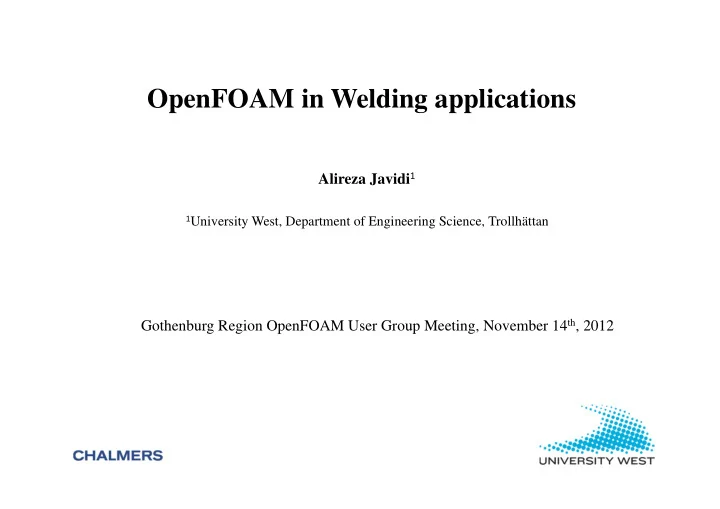

OpenFOAM in Welding applications Alireza Javidi 1 1 University West, Department of Engineering Science, Trollhättan Gothenburg Region OpenFOAM User Group Meeting, November 14 th , 2012
1. Arc 2. Energy coupling between solid and fluid 3. Arc and coupling 4. Melting and phase change
Tungsten Inert Gas welding Ar shielding gas inlet Picture of a TIG torch Sketch of the cross section of a TIG torch
Governing equations: thermal fluid part • (Steady) continuity equation (T) 0 u • (Steady) momentum conservation equation (T) (T) u u u u 2 T ( T ) u ( u ) ( T ) u I P J B 3 Lorentz force • (Steady) enthalpy conservation equation (T) (T) u h h u ( T ) h 5 k J B u P P u J E Q ( T ) h rad 2 eC ( T ) p Joule heating Transport of electron enthalpy
Governing equations: electromagnetic part : Magnetic potential Electric potential : A V 2 A ( T ) V ( T ) V 0 0 with: with: E V B A J ( T ) V : current density J : electric conductivity ( T )
Argon plasma density as function of temperature.
Specific heat as function of temperature
Argon plasma electric conductivity as function of temperature
Ar shielding gas inlet Cathode Cathode a Cathode a Anode Nozzle Inlet Outlet Tip AB BC u 0 0 0 0 0 parabolic � � � � � h or T � � � � 0 � � � � 0 20000K Linear b linear b linear c 300K V or J � �� � � � � � � � � � � � � � � 0 � � � � 0 � � � � 0 � � � � 0 A � � � � � � � � � � � � � � � � � � � � � � � � � � � � � � � � �
Temperature along the radial direction, 1 mm above the anode
“0” “topAir” chtMultiRegionFoam “U” “T” The solver is based on combination of “p” heatConductionFoam and buoyantFoam “bottomSolid” for conjugate heat transfer between a “cp” solid region and fluid region. “K” “T” “rho” “constant” regionProperties “topAir” “polyMesh” thermophysicalProperties g “bottomSolid” “polyMesh” “system” controlDict “topAir” fvSystem fvSolution “bottomSolid” fvSystem fvSolution
� � = ∑ ���
1. Energy balance at cathode/sheath interface 2. Energy balance at sheath/presheath interface 3. Current density conservation
Recommend
More recommend